KIA Optima 2006 2.G Owner's Manual
Manufacturer: KIA, Model Year: 2006, Model line: Optima, Model: KIA Optima 2006 2.GPages: 225, PDF Size: 3.77 MB
Page 201 of 225
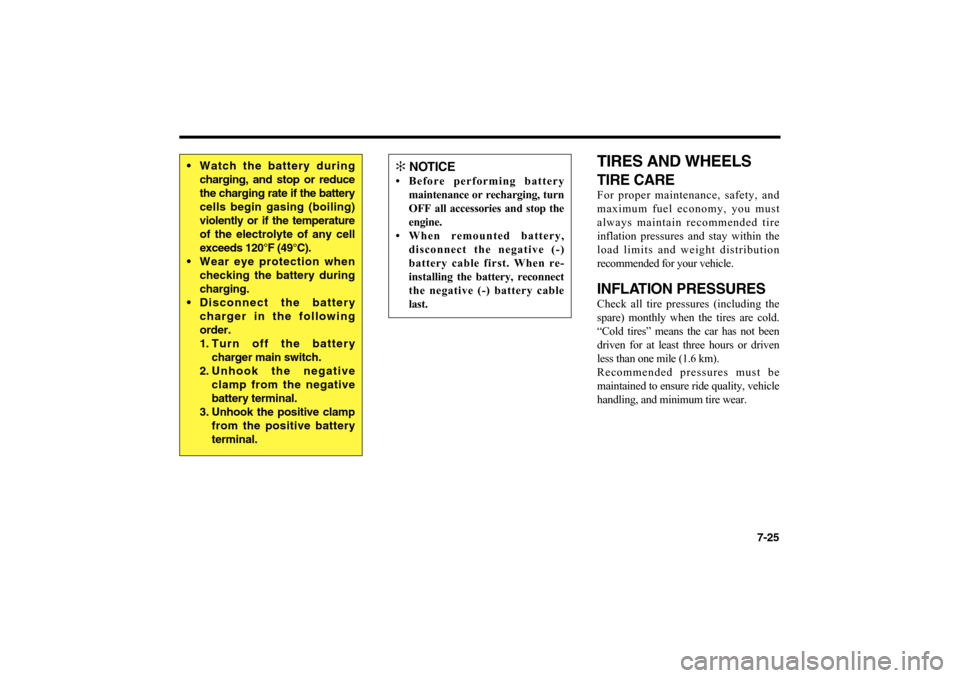
7-25
TIRES AND WHEELSTIRE CAREFor proper maintenance, safety, and
maximum fuel economy, you must
always maintain recommended tire
inflation pressures and stay within the
load limits and weight distribution
recommended for your vehicle.INFLATION PRESSURESCheck all tire pressures (including the
spare) monthly when the tires are cold.
“Cold tires” means the car has not been
driven for at least three hours or driven
less than one mile (1.6 km).
Recommended pressures must be
maintained to ensure ride quality, vehicle
handling, and minimum tire wear.
Watch the battery during
charging, and stop or reduce
the charging rate if the battery
cells begin gasing (boiling)
violently or if the temperature
of the electrolyte of any cell
exceeds 120°F (49°C).
Wear eye protection when
checking the battery during
charging.
Disconnect the battery
charger in the following
order.
1. Turn off the battery
charger main switch.
2. Unhook the negative
clamp from the negative
battery terminal.
3. Unhook the positive clamp
from the positive battery
terminal.
✻
NOTICE
• Before performing battery
maintenance or recharging, turn
OFF all accessories and stop the
engine.
• When remounted battery,
disconnect the negative (-)
battery cable first. When re-
installing the battery, reconnect
the negative (-) battery cable
last.
MS-CNA-Eng 7.QXD 7/25/2005 5:09 PM Page 25
Page 202 of 225

This can be found on the driver side
door.
The correct tire pressure is 210 kPa (30
psi). The compact spare should be at
420kPa (60 psi).
MAINTENANCE
7-26
MMSA7019
✻
NOTICE
• Warm tires normally exceed
recommended cold tire
pressures by 28 to 41 kPa(4 to 6
psi). Do not release air from
warm tires to adjust the
pressure. The tires will become
underinflated when cold.
• Underinflation results in
excessive wear, poor handling,
reduced fuel economy, and the
possibility of blowouts from
overheated tires. Also, low tire
pressure can cause poor sealing
of the tire bead. If the tire
pressure is excessively low,
wheel deformation and/or tire
separation are possible.
Keep tire pressures at the
proper levels. If a tire frequently
needs refilling, have it checked
by an Authorized Kia Dealer or
a tire shop.
• Overinflation produces a harsh
ride, handling problems,
excessive wear at the center of
the tire tread, and a greater
possibility of damage from road
hazards.
WARNING -
Tire Inflation
Overinflation or underinflation
can reduce tire life, adversely
affect vehicle handling, and
lead to sudden tire failure. This
could result in loss of vehicle
control.
MS-CNA-Eng 7.QXD 7/25/2005 5:09 PM Page 26
Page 203 of 225
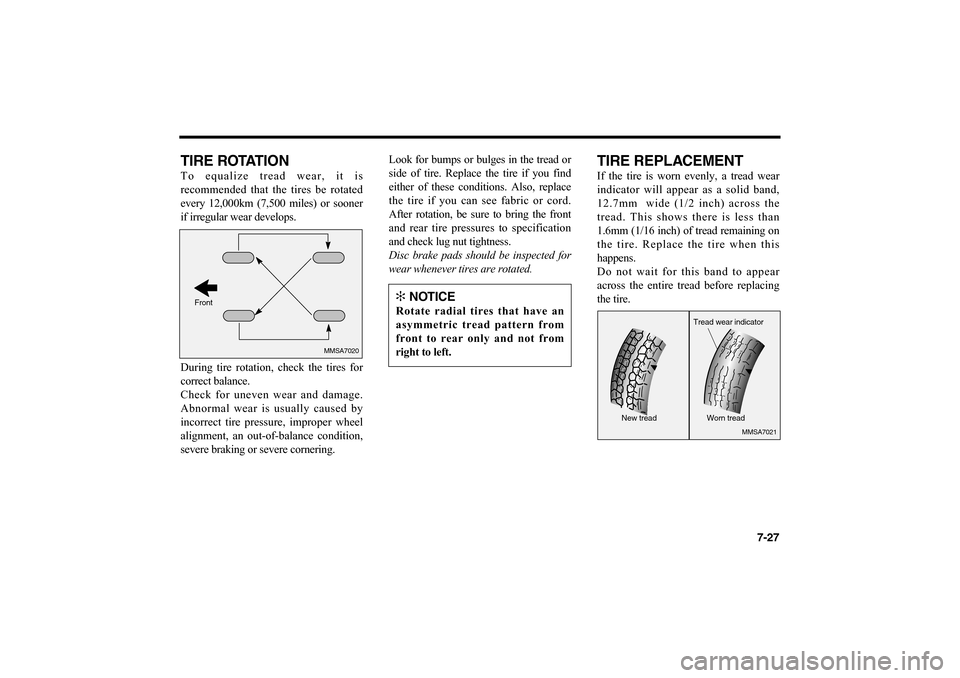
7-27
TIRE ROTATIONTo equalize tread wear, it is
recommended that the tires be rotated
every 12,000km (7,500 miles) or sooner
if irregular wear develops.
During tire rotation, check the tires for
correct balance.
Check for uneven wear and damage.
Abnormal wear is usually caused by
incorrect tire pressure, improper wheel
alignment, an out-of-balance condition,
severe braking or severe cornering.Look for bumps or bulges in the tread or
side of tire. Replace the tire if you find
either of these conditions. Also, replace
the tire if you can see fabric or cord.
After rotation, be sure to bring the front
and rear tire pressures to specification
and check lug nut tightness.
Disc brake pads should be inspected for
wear whenever tires are rotated.
TIRE REPLACEMENTIf the tire is worn evenly, a tread wear
indicator will appear as a solid band,
12.7mm wide (1/2 inch) across the
tread. This shows there is less than
1.6mm (1/16 inch) of tread remaining on
the tire. Replace the tire when this
happens.
Do not wait for this band to appear
across the entire tread before replacing
the tire.
MMSA7020
Front
MMSA7021
New tread Worn treadTread wear indicator
✻
NOTICE
Rotate radial tires that have an
asymmetric tread pattern from
front to rear only and not from
right to left.
MS-CNA-Eng 7.QXD 7/25/2005 5:09 PM Page 27
Page 204 of 225
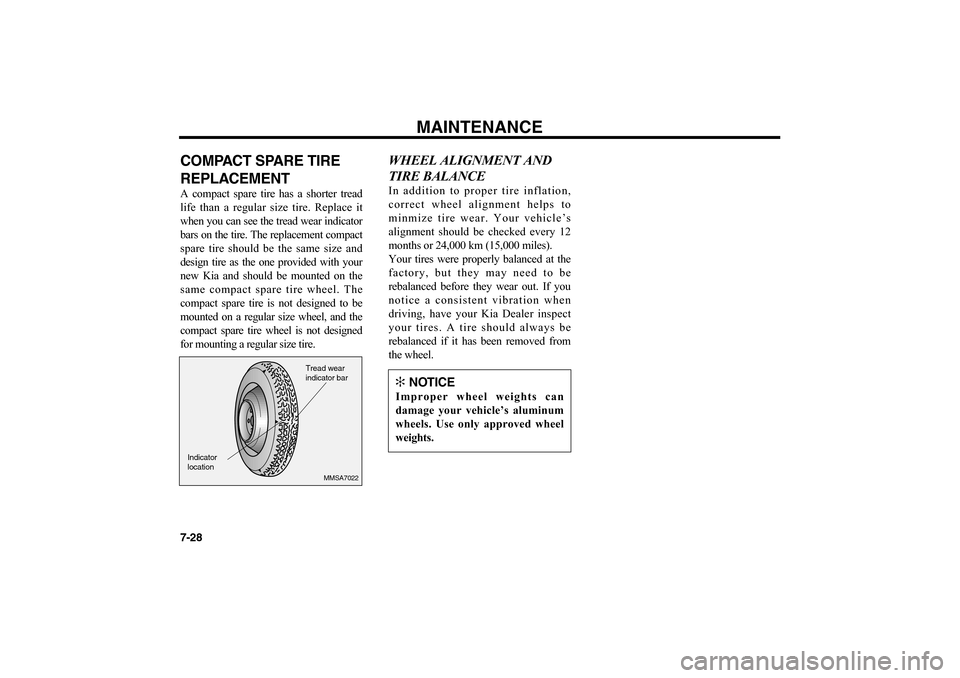
MAINTENANCE
7-28COMPACT SPARE TIRE
REPLACEMENTA compact spare tire has a shorter tread
life than a regular size tire. Replace it
when you can see the tread wear indicator
bars on the tire. The replacement compact
spare tire should be the same size and
design tire as the one provided with your
new Kia and should be mounted on the
same compact spare tire wheel. The
compact spare tire is not designed to be
mounted on a regular size wheel, and the
compact spare tire wheel is not designed
for mounting a regular size tire.
WHEEL ALIGNMENT AND
TIRE BALANCEIn addition to proper tire inflation,
correct wheel alignment helps to
minmize tire wear. Your vehicle’s
alignment should be checked every 12
months or 24,000 km (15,000 miles).
Your tires were properly balanced at the
factory, but they may need to be
rebalanced before they wear out. If you
notice a consistent vibration when
driving, have your Kia Dealer inspect
your tires. A tire should always be
rebalanced if it has been removed from
the wheel.
MMSA7022
Tread wear
indicator bar
Indicator
location
✻
NOTICE
Improper wheel weights can
damage your vehicle’s aluminum
wheels. Use only approved wheel
weights.
MS-CNA-Eng 7.QXD 7/25/2005 5:09 PM Page 28
Page 205 of 225
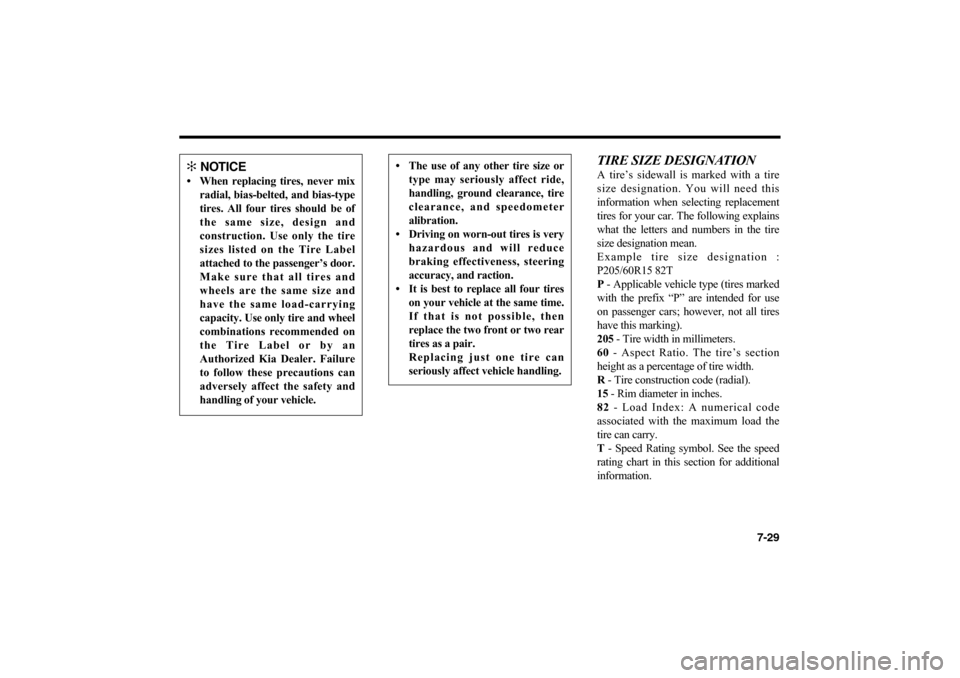
7-29
TIRE SIZE DESIGNATIONA tire’s sidewall is marked with a tire
size designation. You will need this
information when selecting replacement
tires for your car. The following explains
what the letters and numbers in the tire
size designation mean.
Example tire size designation :
P205/60R15 82T
P- Applicable vehicle type (tires marked
with the prefix “P” are intended for use
on passenger cars; however, not all tires
have this marking).
205- Tire width in millimeters.
60- Aspect Ratio. The tire’s section
height as a percentage of tire width.
R- Tire construction code (radial).
15- Rim diameter in inches.
82- Load Index: A numerical code
associated with the maximum load the
tire can carry.
T- Speed Rating symbol. See the speed
rating chart in this section for additional
information.
✻
NOTICE
• When replacing tires, never mix
radial, bias-belted, and bias-type
tires. All four tires should be of
the same size, design and
construction. Use only the tire
sizes listed on the Tire Label
attached to the passenger’s door.
Make sure that all tires and
wheels are the same size and
have the same load-carrying
capacity. Use only tire and wheel
combinations recommended on
the Tire Label or by an
Authorized Kia Dealer. Failure
to follow these precautions can
adversely affect the safety and
handling of your vehicle.
• The use of any other tire size or
type may seriously affect ride,
handling, ground clearance, tire
clearance, and speedometer
alibration.
• Driving on worn-out tires is very
hazardous and will reduce
braking effectiveness, steering
accuracy, and raction.
• It is best to replace all four tires
on your vehicle at the same time.
If that is not possible, then
replace the two front or two rear
tires as a pair.
Replacing just one tire can
seriously affect vehicle handling.
MS-CNA-Eng 7.QXD 7/25/2005 5:09 PM Page 29
Page 206 of 225
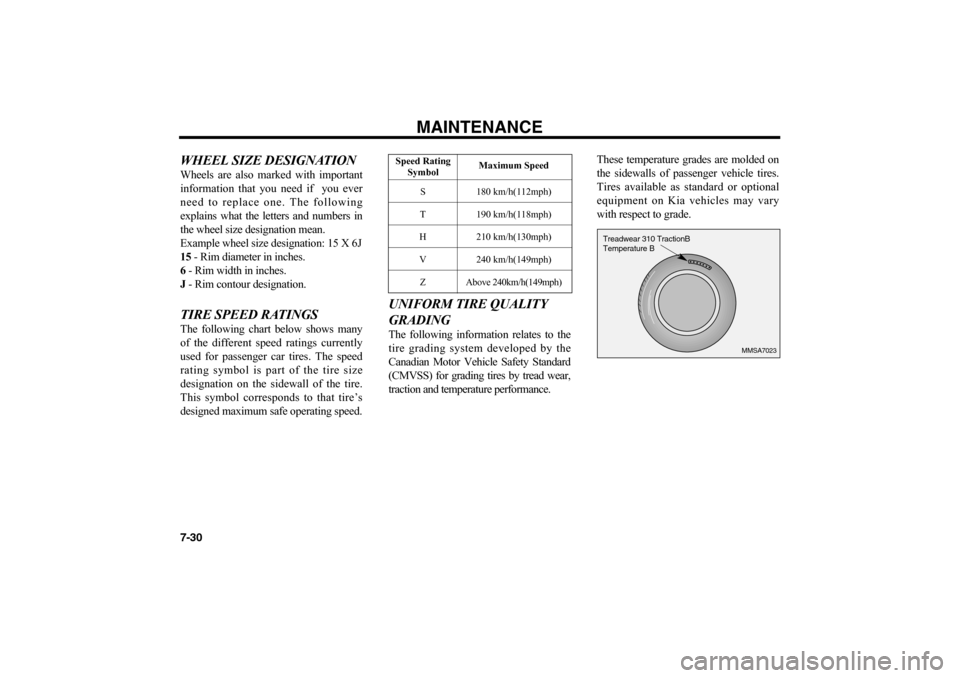
MAINTENANCE
7-30WHEEL SIZE DESIGNATIONWheels are also marked with important
information that you need if you ever
need to replace one. The following
explains what the letters and numbers in
the wheel size designation mean.
Example wheel size designation: 15 X 6J
15 - Rim diameter in inches.
6 - Rim width in inches.
J - Rim contour designation.TIRE SPEED RATINGSThe following chart below shows many
of the different speed ratings currently
used for passenger car tires. The speed
rating symbol is part of the tire size
designation on the sidewall of the tire.
This symbol corresponds to that tire’s
designed maximum safe operating speed.
UNIFORM TIRE QUALITY
GRADINGThe following information relates to the
tire grading system developed by the
Canadian Motor Vehicle Safety Standard
(CMVSS) for grading tires by tread wear,
traction and temperature performance.These temperature grades are molded on
the sidewalls of passenger vehicle tires.
Tires available as standard or optional
equipment on Kia vehicles may vary
with respect to grade.
MMSA7023
Treadwear 310 TractionB
Temperature B
Maximum Speed
S 180 km/h(112mph)
T 190 km/h(118mph)
H 210 km/h(130mph)
V 240 km/h(149mph)
Z Above 240km/h(149mph)
Speed Rating
Symbol
MS-CNA-Eng 7.QXD 7/25/2005 5:09 PM Page 30
Page 207 of 225

7-31
TREAD WEARThe tread wear grade is a comparative
rating based on the wear rate of the tire
when tested under controlled conditions
on a specified government test course.
For example, a tire graded 150 would
wear one-and-a-half times as well on the
government course as a tire graded 100.
The relative performance of tires
depends upon the actual conditions of
their use. Variations in driving habits,
service practices and differences in road
characteristics and climate may
significantly affect performance.TRACTION - A, B AND CThe traction grades, from highest to
lowest, are A, B and C, and they
represent the tire’s ability to stop on wet
pavement as measured under controlled
conditions on specified government test
surfaces of asphalt and concrete. A tire
marked C may have poor traction
performance.
TEMPERATURE-A, B AND CThe temperature grades are A (the
highest), B and C, representing the tire’s
resistance to generate heat and to
dissipate heat when tested under
controlled conditions on a specified
indoor laboratory test wheel. Sustained
high temperatures can cause the material
of the tire to degenerate and reduce tire
life, and excessive temperature can lead
to sudden tire failure. Grade C
corresponds to a level of performance
that all passenger vehicle tires must meet
under the Canadian Motor Vehicle
Safety Standard No. 109: Grades A and
B represent higher levels of performance
on the laboratory test wheel than the
maximum required by law.
WARNING - Tire
Temperature
The temperature grade for a tire
is established for a tire that is
properly inflated and not
overloaded. Excessive speed,
underinflation, or excessive
loading, either separately or in
combination, can cause heat
build-up and possible sudden tire
failure. This can cause loss of
vehicle control and death or
personal injury.
MS-CNA-Eng 7.QXD 7/25/2005 5:09 PM Page 31
Page 208 of 225
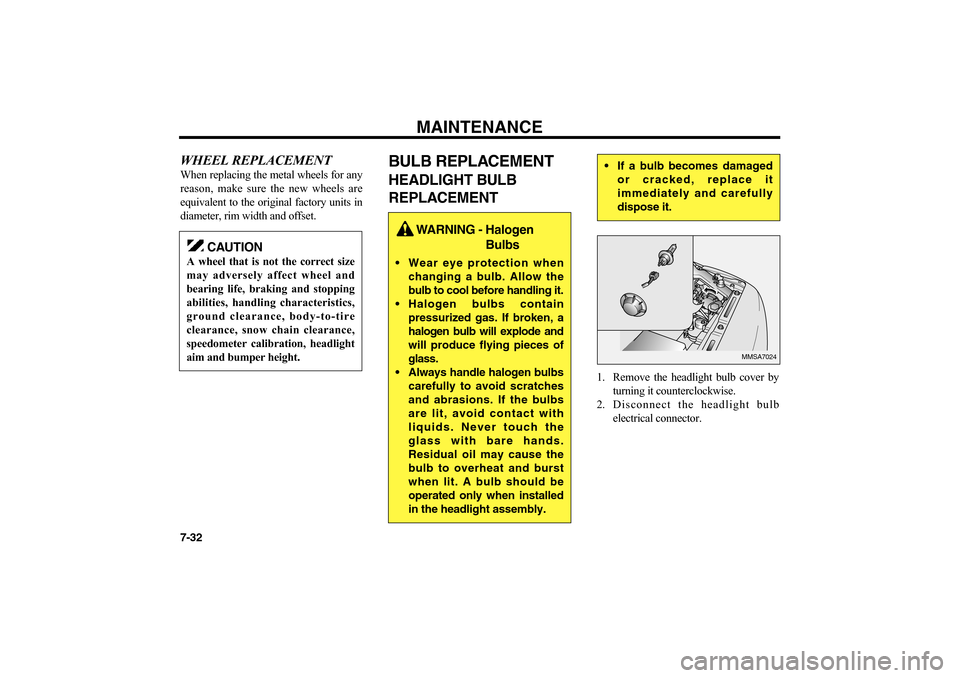
MAINTENANCE
7-32WHEEL REPLACEMENTWhen replacing the metal wheels for any
reason, make sure the new wheels are
equivalent to the original factory units in
diameter, rim width and offset.
BULB REPLACEMENTHEADLIGHT BULB
REPLACEMENT
1. Remove the headlight bulb cover by
turning it counterclockwise.
2. Disconnect the headlight bulb
electrical connector.
MMSA7024
CAUTION
A wheel that is not the correct size
may adversely affect wheel and
bearing life, braking and stopping
abilities, handling characteristics,
ground clearance, body-to-tire
clearance, snow chain clearance,
speedometer calibration, headlight
aim and bumper height.
WARNING - Halogen
Bulbs
Wear eye protection when
changing a bulb. Allow the
bulb to cool before handling it.
Halogen bulbs contain
pressurized gas. If broken, a
halogen bulb will explode and
will produce flying pieces of
glass.
Always handle halogen bulbs
carefully to avoid scratches
and abrasions. If the bulbs
are lit, avoid contact with
liquids. Never touch the
glass with bare hands.
Residual oil may cause the
bulb to overheat and burst
when lit. A bulb should be
operated only when installed
in the headlight assembly.
If a bulb becomes damaged
or cracked, replace it
immediately and carefully
dispose it.
MS-CNA-Eng 7.QXD 7/25/2005 5:09 PM Page 32
Page 209 of 225
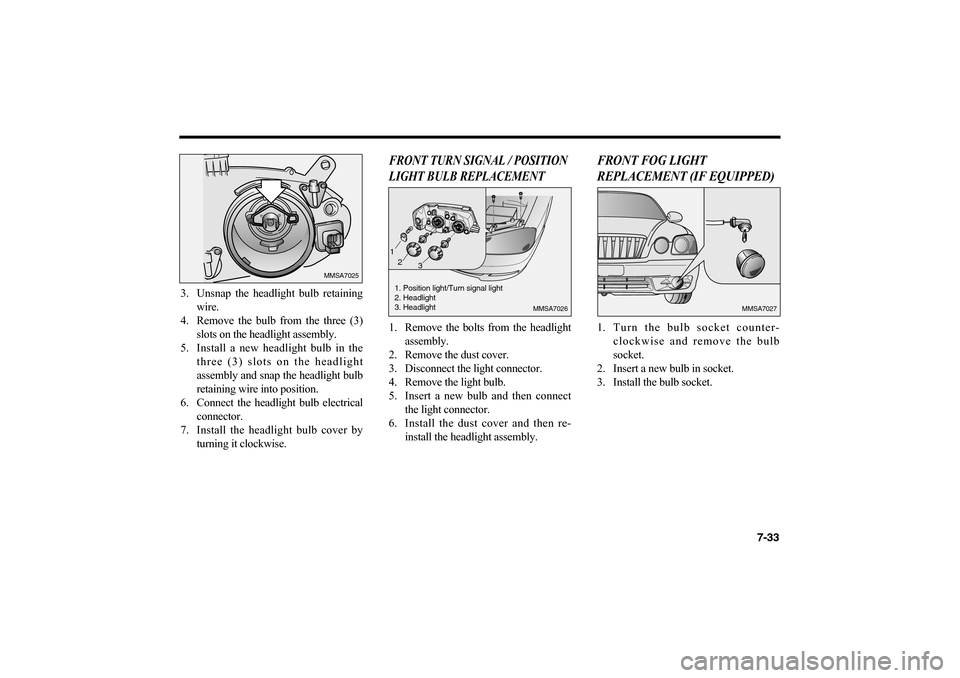
7-33
3. Unsnap the headlight bulb retaining
wire.
4. Remove the bulb from the three (3)
slots on the headlight assembly.
5. Install a new headlight bulb in the
three (3) slots on the headlight
assembly and snap the headlight bulb
retaining wire into position.
6. Connect the headlight bulb electrical
connector.
7. Install the headlight bulb cover by
turning it clockwise.
FRONT TURN SIGNAL / POSITION
LIGHT BULB REPLACEMENT1. Remove the bolts from the headlight
assembly.
2. Remove the dust cover.
3. Disconnect the light connector.
4. Remove the light bulb.
5. Insert a new bulb and then connect
the light connector.
6. Install the dust cover and then re-
install the headlight assembly.
FRONT FOG LIGHT
REPLACEMENT (IF EQUIPPED)1. Turn the bulb socket counter-
clockwise and remove the bulb
socket.
2. Insert a new bulb in socket.
3. Install the bulb socket.
MMSA7025
MMSA7026
1. Position light/Turn signal light
2. Headlight
3. Headlight
MMSA7027
1
2
3
MS-CNA-Eng 7.QXD 7/25/2005 5:09 PM Page 33
Page 210 of 225
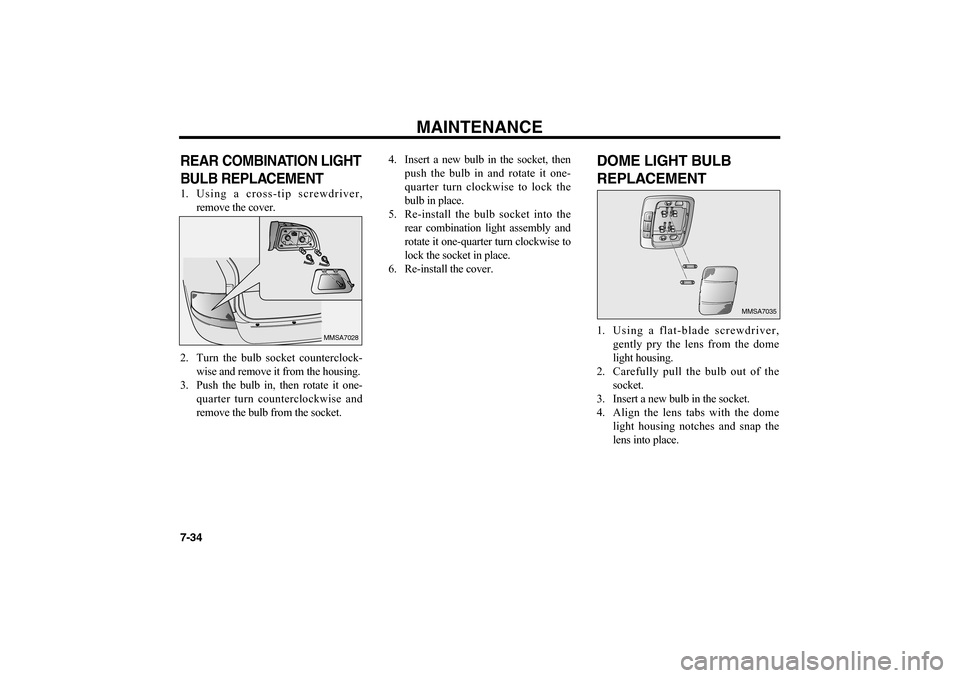
MAINTENANCE
7-34REAR COMBINATION LIGHT
BULB REPLACEMENT 1. Using a cross-tip screwdriver,
remove the cover.
2. Turn the bulb socket counterclock-
wise and remove it from the housing.
3. Push the bulb in, then rotate it one-
quarter turn counterclockwise and
remove the bulb from the socket.4. Insert a new bulb in the socket, then
push the bulb in and rotate it one-
quarter turn clockwise to lock the
bulb in place.
5. Re-install the bulb socket into the
rear combination light assembly and
rotate it one-quarter turn clockwise to
lock the socket in place.
6. Re-install the cover.
DOME LIGHT BULB
REPLACEMENT1. Using a flat-blade screwdriver,
gently pry the lens from the dome
light housing.
2. Carefully pull the bulb out of the
socket.
3. Insert a new bulb in the socket.
4. Align the lens tabs with the dome
light housing notches and snap the
lens into place.
MMSA7028
O
F
FDOORON
MMSA7035
MS-CNA-Eng 7.QXD 7/25/2005 5:09 PM Page 34